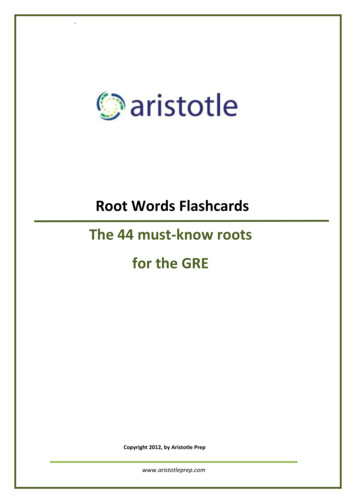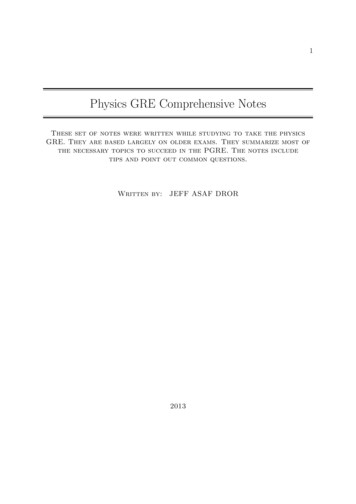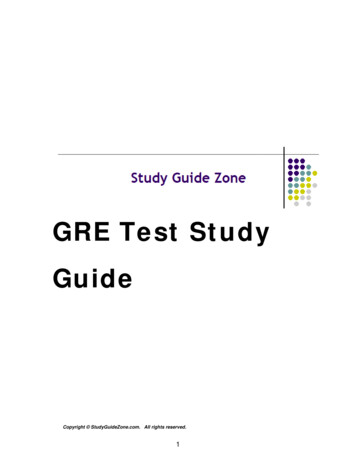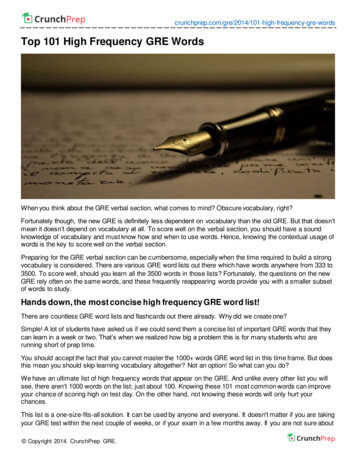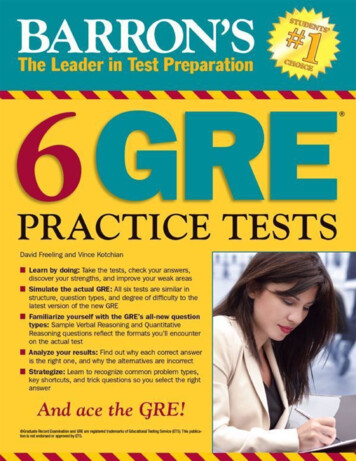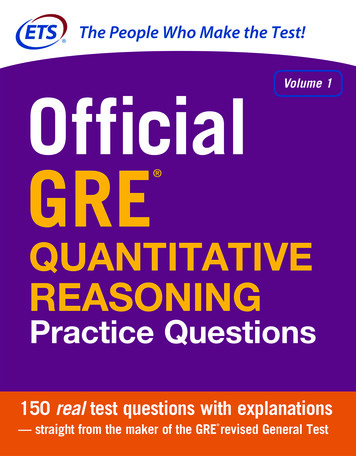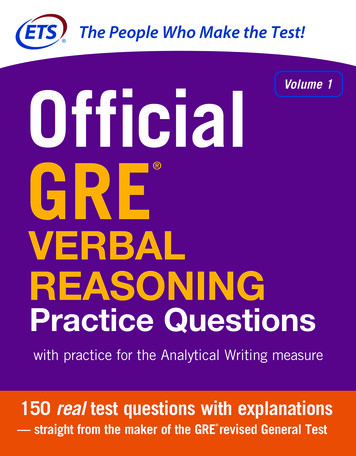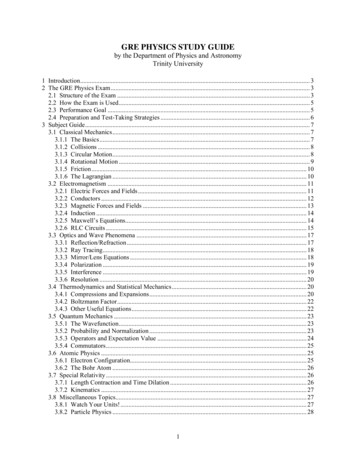
Transcription
GRE PHYSICS STUDY GUIDEby the Department of Physics and AstronomyTrinity University1 Introduction. 32 The GRE Physics Exam. 32.1 Structure of the Exam . 32.2 How the Exam is Used. 52.3 Performance Goal . 52.4 Preparation and Test-Taking Strategies . 63 Subject Guide. 73.1 Classical Mechanics. 73.1.1 The Basics . 73.1.2 Collisions . 83.1.3 Circular Motion. 83.1.4 Rotational Motion . 93.1.5 Friction. 103.1.6 The Lagrangian . 103.2 Electromagnetism . 113.2.1 Electric Forces and Fields . 113.2.2 Conductors . 123.2.3 Magnetic Forces and Fields . 133.2.4 Induction . 143.2.5 Maxwell’s Equations. 143.2.6 RLC Circuits . 153.3 Optics and Wave Phenomena . 173.3.1 Reflection/Refraction . 173.3.2 Ray Tracing. 183.3.3 Mirror/Lens Equations . 183.3.4 Polarization . 193.3.5 Interference . 193.3.6 Resolution . 203.4 Thermodynamics and Statistical Mechanics. 203.4.1 Compressions and Expansions. 203.4.2 Boltzmann Factor. 223.4.3 Other Useful Equations. 223.5 Quantum Mechanics . 233.5.1 The Wavefunction. 233.5.2 Probability and Normalization . 233.5.3 Operators and Expectation Value . 243.5.4 Commutators. 253.6 Atomic Physics . 253.6.1 Electron Configuration. 253.6.2 The Bohr Atom . 263.7 Special Relativity . 263.7.1 Length Contraction and Time Dilation . 263.7.2 Kinematics . 273.8 Miscellaneous Topics. 273.8.1 Watch Your Units! . 273.8.2 Particle Physics . 281
3.8.3 Nuclear Radiation . 284 Practice Test. 294.1 The Test . 294.2 Solutions . 385 You’re Not Done! . 402
1 IntroductionIf you are considering applying to graduate school in physics, you are going to have to take the GREPhysics subject exam. You will find that this exam is different than any other physics test you have takenin a number of ways. Some of these ways will be obvious: the test covers everything you have learned inyour undergraduate physics education, and yet is multiple choice and does not require lengthy integrals orother complicated mathematics. Other differences will be more subtle.The purpose of this document is to help you better understand the exam, so that you can wisely spendyour study and preparation time. Chapter 2 will familiarize you with the format of the exam, set aperformance goal, and describe test-taking strategies you will need to meet that goal. Chapter 3 (the bulkof this document) will give some fundamental physical principles that nearly always appear on the exam,as well as example problems for each subject. Chapter 4 will include a mini-exam that concentrates onthe physics covered in Chapter 3.2 The GRE Physics Exam2.1 Structure of the ExamThe GRE Physics exam consists of 100 questions with a time limit of 170 minutes (2 hours 50 minutes),or just under two minutes per question. Each question is multiple-choice with five answer options given.According to the Educational Testing Service, the typical exam will cover the following subject matter(the percentages indicate on average how many questions address each subject): 20% - Classical Mechanics (such as kinematics, Newton’s laws, work and energy, oscillatorymotion, rotational motion about a fixed axis, dynamics of systems of particles, central forces andcelestial mechanics, three-dimensional particle dynamics, Lagrangian and Hamiltonianformalism, noninertial reference frames, elementary topics in fluid dynamics)18% - Electromagnetism (such as electrostatics, currents and DC circuits, magnetic fields in freespace, Lorentz force, induction, Maxwell’s equations and their applications, electromagneticwaves, AC circuits, magnetic and electric fields in matter)9% - Optics and Wave Phenomena (such as wave properties, superposition, interference,diffraction, geometrical optics, polarization, Doppler effect)10% - Thermodynamics and Statistical Mechanics (such as the laws of thermodynamics,thermodynamic processes, equations of state, ideal gases, kinetic theory, ensembles, statisticalconcepts and calculation of thermodynamic quantities, thermal expansion and heat transfer)12% - Quantum Mechanics (such as fundamental concepts, solutions of the Schrödingerequation (including square wells, harmonic oscillators, and hydrogenic atoms), spin, angularmomentum, wave function symmetry, elementary perturbation theory)10% - Atomic Physics (such as properties of electrons, Bohr model, energy quantization, atomicstructure, atomic spectra, selection rules, black-body radiation, x-rays, atoms in electric andmagnetic fields)6% - Special Relativity (such as introductory concepts, time dilation, length contraction,simultaneity, energy and momentum, four-vectors and Lorentz transformation, velocity addition)6% - Laboratory Methods (such as data and error analysis, electronics, instrumentation,radiation detection, counting statistics, interaction of charged particles with matter, lasers andoptical interferometers, dimensional analysis, fundamental applications of probability andstatistics)3
9% - Specialized Topics (Nuclear and Particle physics (e.g., nuclear properties, radioactivedecay, fission and fusion, reactions, fundamental properties of elementary particles), CondensedMatter (e.g., crystal structure, x-ray diffraction, thermal properties, electron theory of metals,semiconductors, superconductors), Miscellaneous (e.g., astrophysics, mathematical methods,computer applications)The exam is cleverly written. Many of the questions require more than just recalling which equation isapplicable and plugging in numbers, but instead test your physical intuition. My favorite example is thefollowing:1. A block of mass m slides with constant velocity v down aninclined plane with height h and coefficient of friction µ. By thetime the block reaches the bottom of the plane, how much energyhas been dissipated as heat?a. mv2/2b. µmv2/2c. mghd. µmghe. µmgh/2mvhAt first glance, your instinct may be to recall the formulae you usually apply when given a coefficient offriction, F µN µmg cos θ but you are given neither an angle nor the length of the ramp, so you havereached a dead end. Instead, think of the problem this way – you are being asked for an energy, so let usfirst apply conservation of energy. Since the block is sliding with a constant velocity, the kinetic energyis not changing from the top to the bottom of the ramp. Only the potential energy is changing, and sinceit is not being transformed into kinetic energy, it must all be dissipated as heat. Thus the amount ofenergy released as heat equals the change in gravitational potential energy mgh, so the answer is (c).Scoring of the exam is done in a couple of steps. First, you are credited one point for each correct answer,zero points for each omitted question (no answer chosen), and minus one-quarter point for each incorrectanswer. This is called your raw score. So for example, if you answered 64 of the 100 questions, andanswered 48 correctly and 16 incorrectly, your raw score would be 48 – (16/4) 44.Next, the raw score is converted to a scaled score, much like the SAT exam, though in this case the scoresrange from a high of 990 to a low of about 400. The conversion is applied to cancel out the difficultylevel of a particular exam, by requiring that a certain number of examinees score a 990, a few more get980, and so on. This allows scores to be comparable from one exam to the next. Table 1 (again takenfrom the ETS website) shows which scaled scores corresponded to which raw scores for each of threedifferent exams.Scaled Score900800700600Raw ScoresTest B68-6954-554127Test A7358-594430Test C64503827Table 1: Raw scores needed to achieve certain scaled scores on three GRE Physics examsWhen you receive your scores, you will see your raw score, your scaled score, and a percentile. This isthe percentage of examinees whose scores you exceeded. Table 2 shows the raw and scaled scoresassociated with several percentiles for a practice exam on the ETS website.4
The most important lesson to draw from these tables is that the GRE Physics exam is tough! Only asmall number of examinees will exceed even 60% correct. So you should not prepare for the exam bytrying to relearn everything, with the expectation of answering most of the questions correctly. We’ll talkmore about how this will affect your study plan later in this chapter.Percentile99908070605040302010Scaled Score990900820760710660620580530480Raw Score85736153453833272013Table 2: Raw and scaled scores for certain percentiles on sample GRE Physics exam2.2 How the Exam is UsedIt would be impossible to make a blanket statement about how every graduate school uses the GREsubject exam score in their evaluation of applications. Different schools will weight the exam differentlyin their decision-making process, and will have a different definition of “high” and “low” scores.Having said that, the following is true for many graduate schools. Admissions boards look primarily atundergraduate grades (particularly in upper-level physics courses), recommendations, and any researchexperience (always a big plus). The GRE score is typically used as a check, a verification that the studenthas learned the material that the undergraduate transcript says (s)he has been exposed to. It has theadvantage of being calibrated nationwide, unlike grades, which may represent a widely different level ofaccomplishment from one school to the next. An average or better GRE score raises no eyebrows. A lowscore, however, is a red flag to admissions officials that the transcript may not be telling the whole story.2.3 Performance GoalGiven what you have learned about the subject exam, what are you trying to accomplish? Your goalshould be to score well enough to avoid drawing attention away from your strong transcript and researchbackground. So what score should you be trying to achieve?Notice in Table 2 that the scores are most crowded together around the 30th-50th percentile (i.e., thedifference in scores from one line to the next is the smallest). This corresponds to scaled scores in thelow 600’s and raw scores in the low 30’s. So let us say that your performance goal is a scaled score of600. This will put you ahead of at least one-third of examinees, and lumped in with a large crowd ofsimilar scores. Thus it will be unlikely that your score stands out, which is what we want. Note fromTable 1 that a scaled score of 600 is equivalent to a raw score of about 30; this will affect our test-takingstrategies in the next section.5
2.4 Preparation and Test-Taking StrategiesThere are three things you can do to maximize your chance of scoring at least 600, both before and duringthe test: Study a finite set of physics topics thoroughly, rather than everything in brief Take a lot of practice tests Always guess if you are sure you can eliminate at least two answer choicesFirst, let us talk about studying. When preparing for a test about everything, it can be hard to know whereto begin. The temptation is to try to review notes from every physics class you have taken. You usuallyend up covering too much too quickly, and when test time rolls comes you have not relearned any of thematerial well enough to apply it under pressure.But remember, our goal is to get at least 30% of the questions correct, not 80-90%, so there is no need tostudy everything. If you can isolate a finite amount of material that constitutes at least a third of everyGRE physics exam, and learn it thoroughly enough that you are confident that you can answer anyquestion on those subjects, then you are well on your way to meeting your goal. This study guide is acollection of topics that nearly always show up on the exam, so for each concept that you master, youhave effectively added a point to your expected raw score. Concentrate on learning these topics as if youwere taking a final exam in this “course”. Only when you can get a perfect score on the sample exam inChapter 4 should you expand your studying into other areas.Second, you should be taking a lot of practice tests. This will familiarize you with the time limit and thetypes of questions usually asked on the exams, as well as point out to you which topics require furtherreview. You should practice under real testing conditions (no books or equation sheets, adhering strictlyto the time limit), and you should use practice exams as close to the real thing as possible. Werecommend getting GRE: Practicing to Take the Physics Test from the Educational Testing Service,since it includes actual exams; it is out-of-print as of this writing, but you can find used copies at Amazonor Barnes & Noble. The ETS website (http://www.gre.org) also has a sample physics exam in .pdfformat.Third, in order to maximize your score you need to have the courage to guess. Note that if you had noidea what the answer to a question was, guessing would be an even gamble. You’d have a 20% chance ofgaining one point, versus an 80% chance of losing one-quarter of a point, for a net expectation value ofzero ((0.2 x 1) – (0.8 x 0.25) 0). So if you can eliminate even one of the answer choices, it is to youradvantage to guess.We recommend that you not guess if you can eliminate only one answer choice. The reason is that onmost questions, two choices can usually be eliminated for the same straightforward reason, so if you canonly eliminate one you are probably doing something wrong. But if you can eliminate two answerchoices, you MUST guess. To not do so is to give away several points off of your final raw score.The first time you take a practice test, make a note of the questions on which you guess, and when youscore the test, count what percent of these questions you answered incorrectly. It may be discouraging tofind that you got 50-60% of your guesses wrong. But as long as you missed less than 80%, youbenefited from making those guesses. Have courage!So here is our test-taking strategy. Starting as early as August, start reviewing the material in thisdocument, until you can answer every question on the sample test in Chapter 4. Get the ETS booklet andtake a practice exam regularly, perhaps once a weekend, under real testing conditions. Get used to pacing6
yourself – if a question is on a topic you have studied well, take the time to get it right. If not, take aminute to see if you can eliminate two or more answer choices. If you can, guess. Either way, move onto the next question, so that you can see them all in the 170 minutes available. By the time you get to thereal exam, these strategies should be ingrained, and you will do fine.3 Subject GuideReview material in each of the subject categories listed in section 2.1 is included below. An exampleproblem accompanies each topic. Attempt each example problem on your own before looking at thesolution.3.1 Classical Mechanics3.1.1 The Basics12Position, velocity, and acceleration are related by x x0 v0t at 2 , v v0 atMomentum p mvKinetic energy 1 2mv2Force F ma mdv dp dt dtGravitational potential energy mghSpring potential energy 1 2kx2Remember that both momentum and energy are conserved quantities. Also recall that the x, y, and zcomponents of momentum are all independently conserved.Example 1: A particle of mass m is moving along the x-axis with speed v when it collides with a particleof mass 2m initially at rest. After the collision, the first particle has come to rest, and the second particlehas split into two equal-mass pieces that move at equal angles θ 0 with the x-axis, as shown in the figurebelow. Which of the following statements correctly describes the speed of the two pieces?mvmm2mBefore collisiona.b.c.d.e.mθθAfter collisionEach piece moves with speed v.One of the pieces moves with speed v, the other moves with speed less than v.Each piece moves with speed v/2.One of the pieces moves with speed v/2, the other moves with speed greater than v/2.Each piece moves with speed greater than v/2.Answer: Note that we can rule out choices (b) and (d) by symmetry, so we cannot skip this question.The initial momentum in the x-direction is mv, so the final momentum of each particle in the x-direction ismv/2 m(v/2), which means that each particle must have a speed of at least v/2, even if all excess energyis converted to heat. If no heat is released (elastic collision),1 2 1mv 2 mv 2f2 2is less than v but greater than v/2. Thus the correct answer must be (e).7v 0.7v , which , so v f 2
3.1.2 CollisionsThe formulae for collisions can be derived from conservation of momentum and energy, but you may findthat you can work more quickly if you have them memorized. In both cases, we assume a mass m1 ismoving at speed v toward a mass m2 at rest.If the collision is elastic (the two particles do not stick together, no energy lost as heat), thenv1 f m1 m2vm1 m2v2 f 2m1vm1 m2If the collision is inelastic (the two masses stick together, energy is lost as heat), thenvf m1vm1 m2Example 2: A pendulum bob with mass m is released from a heighth as shown in the figure at right. When it reaches the bottom of itsswing, it elastically strikes a mass 2m sitting on a frictionless surface.To what height does the pendulum bob swing back?Answer: The initial gravitational potential energy of the pendulumbob is mgh. At the bottom of the swing, all of this potential energym2mh1 2mv mgh or v 2 gh .22 ghm 2m. Then as the pendulum swings back up, allSince this is an elastic collision, v f 2 gh m 2m3has been converted to kinetic energy, so1212 of this kinetic energy is turned back into gravitational potential energy, so mgh f mv 2f m which gives h f h / 9 .3.1.3 Circular MotionFor circular motion, a v 2 / r . The circumference of one orbit is 2πr, so the time required for one orbit(the period) will be T distance/rate 2π r / v , and the frequency of the orbit will be f 1/T v / 2π r .This will most often come up in relation to planetary motion, so it is useful to mention the relatedgravitational formulae here: gravitational force GMmr2, gravitational potential energy GMmr(with zero potential energy at infinity).Finally, it may also help to remember two of Kepler’s Laws:2nd law: The line joining the Sun and a planet sweeps out equal areas in equal times.3rd law: The square of a planet’s orbital period is proportional to the cube of the semimajor axis of theorbit.822 gh ,3
Example 3: A satellite of mass m orbits a planet of mass M in a circular orbit of radius R. The timerequired for one revolution is:a. independent of Md. proportional to R3/ 2b. proportional to me. proportional to R 2c. linear in RAnswer: We need to find T 2π R / v , which means we need to find v as follows:2π R2πGMGMmv2 R3/ 2 , and the correct answer is (d)., so v Thus T F mam2RRRGM / RGM3.1.4 Rotational Motionθ angular position (in radians)ω angular velocityα angular accelerationNote that if an object is moving at speed v through a circular path of radius r, it will travel through 2πradians when it travels a distance 2πr, so v ωr. Moment of inertia I ρ r 2 dr , where ρ is the density of an object and r is the distance of a given pieceof the object from its center of mass. Some typical values for moment of inertia:1Ml 2 , where l is the length of the rod.121Disc (about axis perpendicular to the center of the disk) MR 2222Sphere (about axis through the center) MR5Rod (about axis perpendicular to the center of the rod) A very useful rule is the parallel-axis theorem: The moment of inertia about an axis parallel to the axisthrough the center of mass is given by I I cm Mh2 , where M is the mass of the object and h is thedistance between the new axis and the center of mass. So for example, the moment of inertial about theend of a rod of length l is given by I I cm Mh 2 211 l Ml 2 M Ml 2123 2 Instead of force, in rotational motion we use torque τ rF sin θ I αAngular momentum L I ωRotational kinetic energy 1 2Iω2Example 4: Seven pennies are arranged in a hexagonal, planar pattern so as to toucheach neighbor, as shown in the figure at right. Each penny is a uniform disk of mass mand radius r. What is the moment of inertia of the system of seven pennies about anaxis that passes through the center of the central penny and is normal to the plane of thepennies?Answer: The moment of inertia through the center of a disk is1Mr 2 . But for six of our seven disks, the2axis of rotation is shifted a distance 2r from the center of mass; by the parallel-axis theorem,I 191552 9 Mr 2 M ( 2r ) Mr 2 . Thus the total moment of inertia is Mr 2 6 Mr 2 Mr 2 .2222 2 9
Example 5: A thin uniform rod of mass M and length L is positionedvertically above an anchored frictionless pivot point, as shown at right, andthen allowed to fall to the ground. With what speed does the free end of therod strike the ground?Answer: The initial potential energy of the rod is given by mghcm mgl / 2 .This will all be converted to kinetic energy, somgl 11 1 I ω 2 ml 2 ω 2 , using the moment of inertia222 3 for the end of a rod that we found on the last page. Solving this equation yields ω 3g / l . Finally,since the end of the rod is moving through a circular path with radius l, v ωl 3gl .3.1.5 FrictionThe force due to friction is given by F µ N sin θ , where µ is the coefficient of friction, N is the normalforce on the object (N ma), and θ is the angle between the force and normal vectors.Example 6: For the system consisting of the two blocks shown atright, the minimum horizontal force F is applied so that the blockB does not fall under the influence of gravity. The masses of Aand B are 16.0 kg and 4.00 kg, respectively. The horizontalsurface is frictionless and the coefficient of friction between thetwo blocks is 0.50. What is the magnitude of F?FABAnswer: Gravity is trying to accelerate block B downward with force Fg mB g . Friction with block Ais pushing block B in the opposite direction with force F f µ N µ mB a , where a is the acceleration ofblock B due to the force F. In order for the block B to not fall, the frictional force must equal thegravitational force, so a g / µ g /(0.5) 2 g . Thus F mtotal a (16kg 4kg ) 2(9.8m / s) 392 N .3.1.6 The LagrangianThe Lagrangian is defined as (Kinetic energy – Potential energy), or symbolically, L T – V. You canexpress this quantity using a position coordinate q and a velocity coordinate q (the time-derivative of q).For a given classical system, this gives you a convenient way to find the system’s equation of motion.First find the Lagrangian, and then apply the following equation: L d L q dt q Example 7: Find the equation of motion for a mass m at a height x under the influence of gravity.1212Answer: The kinetic energy of the mass is given by T mv 2 mx 2 , and the potential energy by1 2dmx mgx . Taking the derivatives shown above gives mg ( mx ) mx . Thus thedt2equation of motion is F mx ma mg , where the negative sign means that gravity is pulling the massV mgx , so L downward with acceleration g, just as we would expect.10
3.2 Electromagnetism3.2.1 Electric Forces and FieldsThe force from an electric charge is given by Coulomb’s law, F kq1q2r2 1q1q24πε 0 r 2. Like charges repel,opposite charges attract.A force from a spherically symmetric shell of charge can be determined very simply. If the point ofinterest is inside the shell, the charge shell has no effect (the individual force vectors from each part of theshell cancel out). If the point of interest is outside of the shell, all of the charge can be assumed to be at apoint at the center of the shell.The electric field at a point is an expression of what force a test charge q would feel if placed at that point:F qE. The electric field will always point in the direction that positive charges want to move – it can beexpressed visually by drawing arrows away from positive charges and towards negative charges. Recalling that work equals force times distance, we define
Physics subject exam. You will find that this exam is different than any other physics test you have taken in a number of ways. Some of these ways will be obvious: the test covers everything you have learned in your undergraduate physics education, and yet is multiple choice and does not re




